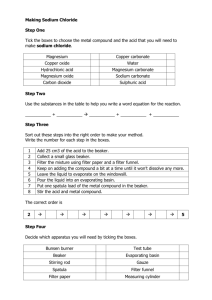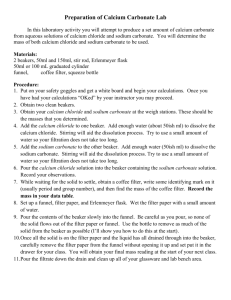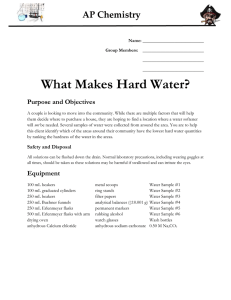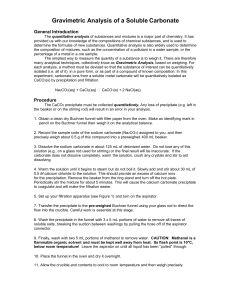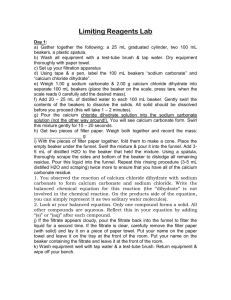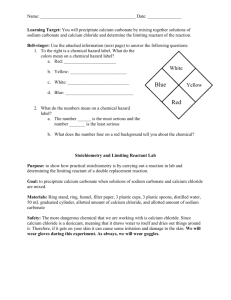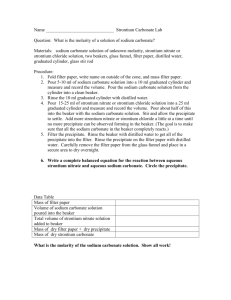Name
advertisement
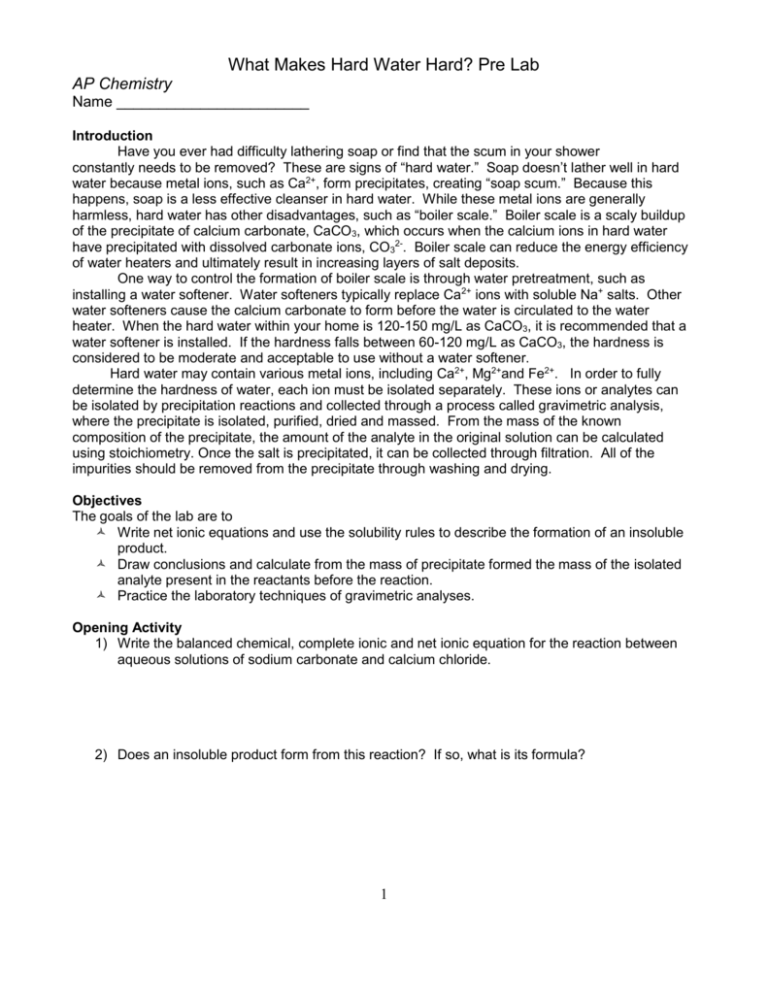
What Makes Hard Water Hard? Pre Lab AP Chemistry Name _______________________ Introduction Have you ever had difficulty lathering soap or find that the scum in your shower constantly needs to be removed? These are signs of “hard water.” Soap doesn’t lather well in hard water because metal ions, such as Ca2+, form precipitates, creating “soap scum.” Because this happens, soap is a less effective cleanser in hard water. While these metal ions are generally harmless, hard water has other disadvantages, such as “boiler scale.” Boiler scale is a scaly buildup of the precipitate of calcium carbonate, CaCO3, which occurs when the calcium ions in hard water have precipitated with dissolved carbonate ions, CO32-. Boiler scale can reduce the energy efficiency of water heaters and ultimately result in increasing layers of salt deposits. One way to control the formation of boiler scale is through water pretreatment, such as installing a water softener. Water softeners typically replace Ca2+ ions with soluble Na+ salts. Other water softeners cause the calcium carbonate to form before the water is circulated to the water heater. When the hard water within your home is 120-150 mg/L as CaCO3, it is recommended that a water softener is installed. If the hardness falls between 60-120 mg/L as CaCO3, the hardness is considered to be moderate and acceptable to use without a water softener. Hard water may contain various metal ions, including Ca2+, Mg2+and Fe2+. In order to fully determine the hardness of water, each ion must be isolated separately. These ions or analytes can be isolated by precipitation reactions and collected through a process called gravimetric analysis, where the precipitate is isolated, purified, dried and massed. From the mass of the known composition of the precipitate, the amount of the analyte in the original solution can be calculated using stoichiometry. Once the salt is precipitated, it can be collected through filtration. All of the impurities should be removed from the precipitate through washing and drying. Objectives The goals of the lab are to Write net ionic equations and use the solubility rules to describe the formation of an insoluble product. Draw conclusions and calculate from the mass of precipitate formed the mass of the isolated analyte present in the reactants before the reaction. Practice the laboratory techniques of gravimetric analyses. Opening Activity 1) Write the balanced chemical, complete ionic and net ionic equation for the reaction between aqueous solutions of sodium carbonate and calcium chloride. 2) Does an insoluble product form from this reaction? If so, what is its formula? 1 3) A student carries out a reaction using 2.0 g of sodium carbonate and 2.0 g of calcium chloride. Which is the limiting reactant? 4) How many grams of calcium carbonate should be produced? 5) If the same student carries out a gravimetric analysis, with an unknown amount of calcium chloride and an excess of sodium carbonate that resulted in the formation of 0.9887 g of calcium carbonate, how many grams of calcium chloride must have reacted? Materials: Sodium carbonate, Na2CO3 Calcium chloride,CaCl2 Weighing paper balance Scoopula 2 – 50 ml beaker 25 ml graduated cylinder deionized water stirring bars Filter paper Vacuum filtration system (if available) Permanent marker Watch glass Drying oven (if available) Rubbing alcohol goggles and aprons Procedure: 1. Weigh 2 g of sodium carbonate in a clean, dry 50 ml beaker. Note mass ___________g 2. Weigh 2 g of calcium chloride in a clean, dry 50 ml beaker. Note mass ___________g 3. To each beaker, add about 20 ml of distilled water. Stir each with a glass stirring rod until each solid is dissolved. 4. Pour a small amount of the sodium carbonate solution into the beaker containing the calcium chloride solution. Stir and observe the mixture. Add some more of the sodium carbonate solution while stirring and observing. After all the sodium carbonate solution has been added, continue to stir this mixture for another couple of minutes. 5. Weigh out a piece of filter paper. Note the mass ___________g 6. Fold the filter paper following the images below and following your instructor's lead. 2 7. Set up the filtering apparatus. 8. Insert the filter paper into the filtering apparatus. Wet the filter paper with distilled water. 9. Pour the contents of your beaker slowly into the filter paper inside the funnel. Be careful as you pour so that none of the mixture flows out of the filter paper or the funnel. Use a wash bottle of distilled water to rinse the precipitate out of the beaker with small quantities of water. Use a little more water to wash the precipitate that is now collected in the filter paper. 10. Using a permanent marker, label a clean, dry watch glass with your initials. 11. Weigh the watch glass. Note the mass ____________g 12. Carefully remove the filter paper with the precipitate from the filtering apparatus and set it on the watch glass. The filtrate, the solution remaining in the beaker, can be poured down the drain. 13. If a drying oven is available allow the filter paper to dry for 10-15 minutes. If not, allow to dry overnight and continue with step 16. Note mass 14. Carefully remove the warm watch glass. Use a metal scoop to break the precipitate into small pieces. Set aside to cool. Note the mass ____________g 15. Return the watch glass to the drying oven for another 5 minutes. 16. Carefully remove the watch glass out of the oven and set aside to cool. 17. Weigh the watch glass, filter paper and precipitate again. Note the mass ___________g. 18. Subtract the mass of the watch glass and filter from the mass of the watch glass, filter paper and precipitate. Note the mass ____________g 19. The precipitate and filter paper may be discarded in the waste basket. Wipe the permanent marker off of the watch glass using some rubbing alcohol. Conclusion and Analysis 1. What is the mass of your calcium carbonate precipitate? 2. How does this value compare with the theoretical mass you calculated in Question # 4 of the opening activity? 3. If they vary, what reasons could exist for the differences? 4. Would the mass of precipitate that you collected be larger or smaller if you did not wash the precipiate before drying it? 5. If the precipitate was weighed without drying, would you believe that you had started with 2 grams of calcium chloride? Explain. 6. Do you feel that the second weighing of your precipitate was significantly drier than your first weighing? 7. If 1.0 additional gram of sodium carbonate was added how would it affect the amount of caclium carbonate that would form? 8. What evidence do you have that all of the calcium ion was precipitated? 9. Summarize the data you collected into a data table and detail it below. 3
